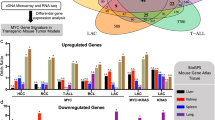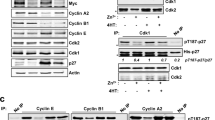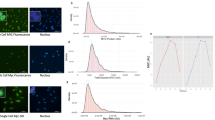Abstract
The myc family of genes plays an important role in several cellular processes including proliferation, apoptosis, differentiation, and transformation. B-myc, a relatively new and largely unstudied member of the myc family, encodes a protein that is highly homologous to the N-terminal transcriptional regulatory domain of c-Myc. Here, we show that high level B-myc expression is restricted to specific mouse tissues, primarily hormonally-controlled tissues, with the highest level of expression in the epididymis. We also report the identification of the endogenous B-Myc protein from mouse tissues. Like other Myc family proteins, B-Myc is a short-lived nuclear protein which is phosphorylated on residues Ser-60 and Ser-68. Rapid proteolysis of B-Myc occurs via the ubiquitin-proteasome pathway. Finally, we found that overexpression of B-Myc significantly slows the growth of Rat 1a fibroblasts and COS cells suggesting B-Myc functions as an inhibitor of cellular proliferation.
This is a preview of subscription content, access via your institution
Access options
Subscribe to this journal
Receive 50 print issues and online access
$259.00 per year
only $5.18 per issue
Buy this article
- Purchase on Springer Link
- Instant access to full article PDF
Prices may be subject to local taxes which are calculated during checkout







Similar content being viewed by others
References
Asker C, Magnusson K, Piccoli S, Andersson K, Klein G, Cole M and Wiman K. . 1995 Oncogene 11: 1963–1969.
Asker C, Steinitz M, Andersson K, Sumegi J, Klein G and Ingvarsson S. . 1989 Oncogene 4: 1523–1527.
Chang DW, Claassen GF, Hann SR and Cole MD. . 2000 Mol. Cell. Biol. 20: 4309–4319.
Ciechanover A. . 1994 Cell 79: 13–21.
DePinho RA, Schreiber-Agus N and Alt FW. . 1991 Adv. Cancer Res. 57: 1–46.
Domashenko AD, Latham KE and Hatton KS. . 1997 Mol. Reprod. Develop. 47: 57–65.
Eilers M, Picard D, Yamamoto KR and Bishop JM. . 1989 Nature 340: 66–68.
Facchini LM and Penn LZ. . 1998 FASEB J. 12: 633–651.
Grandori C and Eisenman R. . 1997 TIBS. 22: 177–181.
Gregory MA and Hann SR. . 2000 Mol. Cell. Biol. 20: 2423–2435.
Gross-Mesilaty S, Reinstein E, Bercovich B, Tobias KE, Schwartz AL, Kahana C and Ciechanover A. . 1998 Proc. Natl. Acad. Sci. USA 95: 8058–8063.
Hann SR, Abrams HD, Rohrschneider LR and Eisenman RN. . 1983 Cell 34: 789–798.
Hann SR and Eisenman RN. . 1984 Mol. Cell. Biol. 4: 2486–2497.
Henriksson M, Bakardjiev A, Klein G and Luscher B. . 1993 Oncogene 8: 3199–3209.
Henriksson M and Luscher B. . 1996 Adv. Cancer Res. 68: 109–182.
Ingvarsson S, Asker C, Axelson H, Klein G and Sumegi J. . 1988a Mol. Cell. Biol. 8: 3168–3174.
Ingvarsson S, Sundaresan S, Jin P, Francke U, Asker C, Sumegi J, Klein G and Sejersen T. . 1988b Oncogene 3: 679–685.
Kunkel TA. . 1985 Proc. Natl. Acad. Sci. U.S.A. 82: 488–492.
Lutterbach B and Hann SR. . 1997 Oncogene 14: 967–975.
Lutterbach B and Hann SR. . 1994 Mol. Cell. Biol. 14: 5510–5522.
Marcu KB, Bossone SA and Patel AJ. . 1992 Annu. Rev. Biochem. 61: 809–860.
Mateyak MK, Obaya AJ, Adachi S and Sedivy JM. . 1997 Cell Growth Differ. 8: 1039–1048.
McMahon SB, Van Buskirk HA, Dugan KA, Copeland TD and Cole MD. . 1998 Cell 94: 363–374.
Noguchi K, Kitanaka C, Yamana H, Kokubu A, Mochizuki T and Kuchino Y. . 1999 J. Biol. Chem. 274: 32580–32587.
O'Hagan RC, Tozer RG, Symons M, McCormick F and Hassell JA. . 1996 Oncogene 13: 1323–1333.
Panno JP and McKeown BA. . 1993 Comp. Biochem. Physiol. 104B: 649–652.
Pulverer BJ, Fischer K, Vousden K, Littlewood T, Evan G and Woodgett JR. . 1994 Oncogene 9: 59–70.
Resar LMS, Dolde C, Barret JF and Dang CV. . 1993 Mol. Cell. Biol. 13: 1130–1136.
Rock KL, Gramm C, Rothstein L, Clark K, Stein R, Dick L, Hwang D and Goldberg AL. . 1994 Cell 78: 761–771.
Salghetti SE, Kim SY and Tansey WP. . 1999 EMBO J. 18: 717–726.
Schmid P, Schulz WA and Hameister H. . 1989 Science 243: 226–229.
Semsei I, Ma S and Cutler RG. . 1989 Oncogene 4: 465–470.
Smith D and Johnson K. . 1988 Gene 67: 31–40.
Spotts GD, Patel SV, Xiao Q and Hann SR. . 1997 Mol. Cell. Biol. 17: 1459–1468.
Tashjian AH, Bancroff FC and Levine L. . 1970 J. Cell Biol. 47: 61–70.
Treier M, Staszewski LM and Bohmann D. . 1994 Cell 78: 787–798.
Turgeon JL, Kimura Y, Waring DW and Mellon PL. . 1996 Mol. Endocrinol. 10: 439–450.
Xiao Q, Claassen G, Shi J, Adachi S, Sedivy J and Hann SR. . 1998 Genes Dev. 12: 3803–3808.
Xin J-H, Cowie A, Lachance P and Hassell JA. . 1992 Genes Dev. 6: 481–496.
Zimmerman KA, Yancopoulos GD, Collum RG, Smith RK, Kohl NE, Denis KA, Nau MM, Witte ON, Toren-Allerand D, Gee CE, Minna JD and Alt FW. . 1986 Nature 319: 780–783.
Acknowledgements
We thank Jingyu Shi and Diane Page for excellent technical assistance. This work was supported by US Public Health Service grants CA47399 (SR Hann) and CA78888 (SR Hann) from the National Cancer Institute and HD33903 (GA Cornwall) from the NICHD.
Author information
Authors and Affiliations
Rights and permissions
About this article
Cite this article
Gregory, M., Xiao, Q., Cornwall, G. et al. B-Myc is preferentially expressed in hormonally-controlled tissues and inhibits cellular proliferation. Oncogene 19, 4886–4895 (2000). https://doi.org/10.1038/sj.onc.1203851
Received:
Revised:
Accepted:
Published:
Issue Date:
DOI: https://doi.org/10.1038/sj.onc.1203851
Keywords
This article is cited by
-
Postnatal liver growth and regeneration are independent of c-myc in a mouse model of conditional hepatic c-myc deletion
BMC Physiology (2012)
-
Why are epididymal tumours so rare?
Asian Journal of Andrology (2012)



